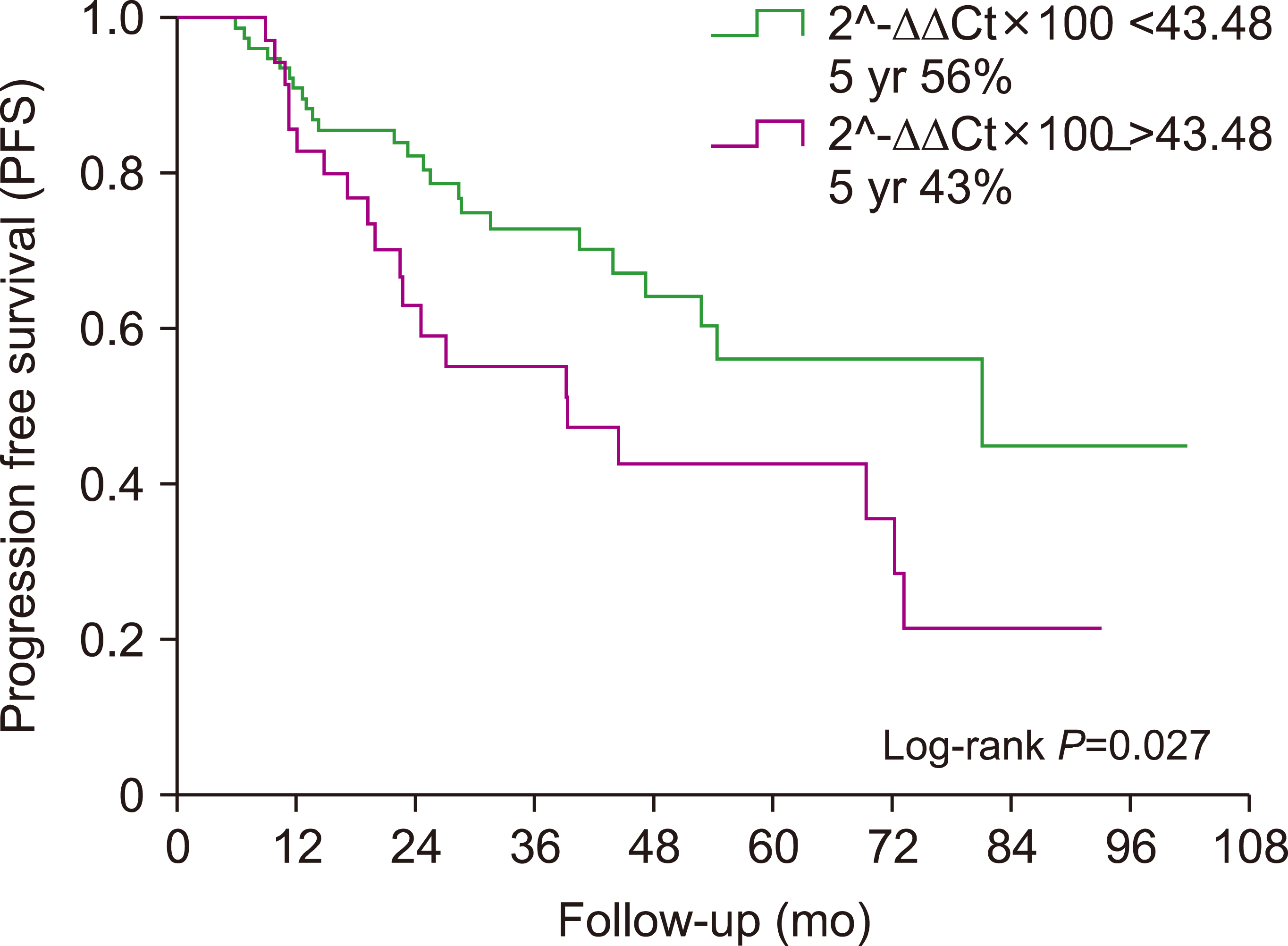2. Palumbo A, Avet-Loiseau H, Oliva S, et al. 2015; Revised International Staging System for Multiple Myeloma: a report from International Myeloma Working Group. J Clin Oncol. 33:2863–9. DOI:
10.1200/JCO.2015.61.2267. PMID:
26240224. PMCID:
PMC4846284.
3. Fonseca R, Bergsagel PL, Drach J, et al. 2009; International Myeloma Working Group. International Myeloma Working Group molecular classification of multiple myeloma: spotlight review. Leukemia. 23:2210–21. DOI:
10.1038/leu.2009.174. PMID:
19798094. PMCID:
PMC2964268.
4. Depil S, Leleu X, Micol JB, et al. 2004; Abnormal cytogenetics and significant bone marrow plasmacytosis are predictive of early progression and short survival in patients with low tumor mass asymptomatic multiple myeloma. Leuk Lymphoma. 45:2481–4. DOI:
10.1080/10428190412331283224. PMID:
15621764.
5. Guedes RA, Planello AC, Andia DC, De Oliveira NF, de Souza AP. 2015; Association of SOCS1 (-820) (rs33977706) gene polymorphism with chronic periodontitis: a case-control study in Brazilians. Meta Gene. 5:124–8. DOI:
10.1016/j.mgene.2015.06.005. PMID:
26199896. PMCID:
PMC4506993.
6. Harada M, Nakashima K, Hirota T, et al. 2007; Functional polymorphism in the suppressor of cytokine signaling 1 gene associated with adult asthma. Am J Respir Cell Mol Biol. 36:491–6. DOI:
10.1165/rcmb.2006-0090OC. PMID:
17099141.
7. Sharma A, Heuck CJ, Fazzari MJ, et al. 2010; DNA methylation alterations in multiple myeloma as a model for epigenetic changes in cancer. Wiley Interdiscip Rev Syst Biol Med. 2:654–69. DOI:
10.1002/wsbm.89. PMID:
20890963.
8. Galm O, Yoshikawa H, Esteller M, Osieka R, Herman JG. 2003; SOCS-1, a negative regulator of cytokine signaling, is frequently silenced by methylation in multiple myeloma. Blood. 101:2784–8. DOI:
10.1182/blood-2002-06-1735. PMID:
12456503.
9. Depil S, Saudemont A, Quesnel B. 2003; SOCS-1 gene methylation is frequent but does not appear to have prognostic value in patients with multiple myeloma. Leukemia. 17:1678–9. DOI:
10.1038/sj.leu.2403012. PMID:
12886263.
10. Reddy J, Shivapurkar N, Takahashi T, et al. 2005; Differential methylation of genes that regulate cytokine signaling in lymphoid and hematopoietic tumors. Oncogene. 24:732–6. DOI:
10.1038/sj.onc.1208032. PMID:
15580314.
12. Duncan BK, Miller JH. 1980; Mutagenic deamination of cytosine residues in DNA. Nature. 287:560–1. DOI:
10.1038/287560a0. PMID:
6999365.
13. Fazzari MJ, Greally JM. 2004; Epigenomics: beyond CpG islands. Nat Rev Genet. 5:446–55. DOI:
10.1038/nrg1349. PMID:
15153997.
15. Oz Gul O, Cander S, Gul CB, Budak F, Oral B, Ersoy C. 2017; Cytokine signal suppressor (SOCS) 1-1478 CA/del gene polymorphism in Turkish patients with polycystic ovary syndrome. J Obstet Gynaecol. 37:896–901. DOI:
10.1080/01443615.2017.1309011. PMID:
28569589.
16. Chan MW, Chu ES, To KF, Leung WK. 2004; Quantitative detection of methylated SOCS-1, a tumor suppressor gene, by a modified protocol of quantitative real time methylation-specific PCR using SYBR green and its use in early gastric cancer detection. Biotechnol Lett. 26:1289–93. DOI:
10.1023/B:BILE.0000044922.43572.2d. PMID:
15483389.
17. Li B, Chen X, Jiang Y, et al. 2017; CCL2 promoter hypomethylation is associated with gout risk in Chinese Han male population. Immunol Lett. 190:15–9. DOI:
10.1016/j.imlet.2017.06.011. PMID:
28690186.
18. Ma H, Chen X, Hu H, et al. 2018; Hypermethylation of MDFI promoter with NSCLC is specific for females, non-smokers and people younger than 65. Oncol Lett. 15:9017–24. DOI:
10.3892/ol.2018.8535. PMID:
29805634. PMCID:
PMC5958687.
19. Brand S, Zitzmann K, Dambacher J, et al. 2005; SOCS-1 inhibits expression of the antiviral proteins 2',5'-OAS and MxA induced by the novel interferon-lambdas IL-28A and IL-29. Biochem Biophys Res Commun. 331:543–8. DOI:
10.1016/j.bbrc.2005.04.004. PMID:
15850793.
20. Yang T, Liu X, Kumar SK, Jin F, Dai Y. 2022; Decoding DNA methylation in epigenetics of multiple myeloma. Blood Rev. 51:100872. DOI:
10.1016/j.blre.2021.100872. PMID:
34384602.
22. Pehlivan S, Serin I, Nursal AF, Oyaci Y, Gundes I, Pehlivan M. 202; What are the roles of global DNA and APC 2 gene promotor hypermethylation in multiple myeloma? Mol Biol Rep. 48:7875–82. DOI:
10.1007/s11033-021-06813-z. PMID:
34637096. PMCID:
PMC8505470.
23. Chim CS, Fung TK, Cheung WC, Liang R, Kwong YL. 2004; SOCS1 and SHP1 hypermethylation in multiple myeloma: implications for epigenetic activation of the Jak/STAT pathway. Blood. 103:4630–5. DOI:
10.1182/blood-2003-06-2007. PMID:
14976049.
24. Kalff A, Khong T, Mithraprabhu S, et al. 2019; Oral azacitidine (CC-486) in combination with lenalidomide and dexamethasone in advanced, lenalidomide-refractory multiple myeloma (ROAR study). Leuk Lymphoma. 60:2143–51. DOI:
10.1080/10428194.2019.1571201. PMID:
31184224.
25. Reu FJ, Grabowski D, Mahfouz RZ, et al. 2015; A phase I/II trial of very low to low-dose continuous azacitidine in combination with standard doses of lenalidomide and low-dose dexamethasone in patients with relapsed or refractory multiple myeloma. J Clin Oncol. 33(15 Suppl):8584. DOI:
10.1200/jco.2015.33.15_suppl.8584.
26. Khong T, Sharkey J, Spencer A. 2008; The effect of azacitidine on interleukin-6 signaling and nuclear factor-kappaB activation and its in vitro and in vivo activity against multiple myeloma. Haematologica. 93:860–9. DOI:
10.3324/haematol.12261. PMID:
18443271.





 PDF
PDF Citation
Citation Print
Print


 XML Download
XML Download